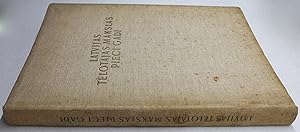About this Item
Latvian language, with detailed summary on French and German. Large album format. Octavo 26 x 35 cm. Weight approx. 2250 g. Wrappers, 100 [4] pp., [13] mounted color illustration plates protected with intervaling tissue paper, CXXIX illustration tables. High quality printing on coated fine paper. The book is in Near Fine condition without any visible defects, losses, remarks and stains. Foxing stains on the cloth binding; internally few occasional foxing spots thoughout, but mainly on title page, on intevalling tissue paper, and on the pages there illustration plates tipped-on. The retrospective begins with a copper engraving of portrait of President Karlis Ulmanis and reveals the influence of the authoritarian regime of Ulmanis on the processes in the art life, in which on the occasion of the anniversary of the renewed Latvia the gains of art are presented in the official style based on the spirit of unity. The ideas and the visual material of the publication illustrate the concept that the creative processes have reached their culmination in the golden age of the art renaissance - in the five years of the Ulmanis regime. In fact, it is the only publication in which authoritarianism and art reflect the culture policies of the period so distinctly. The work detailed the organization of artists, the arts centres created in the provinces, and exhibitions mounted abroad. The most important newly established structures in the field of art were Chamber of literature and art (15th May 1938) created to monitor developments and represent professional interests, and the Association of Latvian Artists (Latvijas telotajas makslas biedriba) in which on the 14th November 1938 all the associations existing before were brought together. In the provincial towns Jelgava, Liepaja, Rezekne, Tukums, Cesis, etc. were opened new schools and museums with arts learning opportunities, organized numerous art exhibitions. During the period 1934-39 Latvian presence abroad in the form of art exhibitions was at it greatest. Exhibitions were held in Helsinki, Tallinn and Tartu, Warsaw and Cracow, Wien, Budapest, Prague, Kaunas, Copenhagen, Paris and London. As for the status of artists, the introduction by Julijs Druva, Chairman of the Chamber of literature and art, offers a glimpse of the regime's vision: artists are honoured and recognized in the same way as they were during the great historical periods of artistic development. The development of Latvian art in the publication is interpreted by painter Janis Silins (painting section), sculptor Ernests Brastin (overview of sculpture), artist and art critic Jekabs Strazdin (article about graphic art), painter and art critic Jekabs Bine (applied arts output). Especially emphasized 'national' character of creativity. In each art section described recent achievements, given brief characterictic of creativity of its important representatives. Among painters considered as old masters - Wilhelms Purvitis, Janis Kuga, Janis Tilbergs, Aleksandrs trals, Karlis Brencens, etc., so new modernist generation Ludolfs Liberts, Uga Skulme, Leo Svemps, Valdemars Tone, Konrads Ubans, Romans Suta, Niklavs Strunke, Augusts Annus, Jekabs Bine, and many others. Among prominent sculptors were mentioned - Gustavs kilters, Teodors Zalkalns, Burkards Dzenis, Karlis Zale, Marta Skulme, Arturs Bernieks, Voldemars Jakobsons, etc. Reachly illustrated album includes 13 tipped-in color illustration plates, and over 200 artworks images on 129 tables. Seller Inventory # 194
Contact seller
Report this item
![]()




